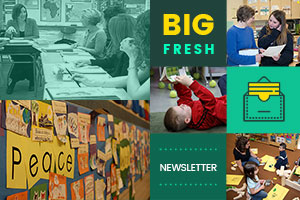The art of teaching is the art of assisting discovery.
―Mark Van Doren
The Art of Teaching
Sometimes I feel like there is a lot of pressure to teach readers the right thing in the right order at the right time. There are pristine curriculum guides that promise humans will learn to read if they progress through the pages in a systematic way. There are resources that guarantee a structure that will allow all students to read in a set time frame.
Sometimes it feels like we’ve bent to the science of instruction and forgotten about the art of instruction. As if science has all of the answers to teaching a child to read.
I’m reminded of a quote from the iconic Bird by Bird by Anne Lamott:
Perfectionism is the voice of the oppressor, the enemy of the people. It will keep you cramped and insane your whole life…I think perfectionism is based on the obsessive belief that if you run carefully enough, hitting each stepping-stone just right, you won’t have to die. The truth is that you will die anyway and that a lot of people who aren’t even looking at their feet are going to do a whole lot better than you, and have a lot more fun while they’re doing it.
It is a nice and tidy thought to believe that if we follow a path and hit each stepping-stone just right, children will learn to read. It’s true that we know more about how children learn to read and write than at any other time in history. I’m not saying that we shouldn’t approach reading instruction with a plan and guide for teaching.
It’s just that there is more to learning to read than being told how sounds and words and sentences work. Just as necessary is developing the identity of a reader. Becoming a reader is something that happens within our hearts, not just our minds. It is something that no one can do for us or to us, but something that each person must own and become for themselves.
This week we look at nurturing independence in learners—plus more, as always.
Shine on,
Ruth Ayres
Editor in Chief

Tara Barnett and Kate Mills offer advice about how to handle issues that often crop up as students design and work through their independent writing projects.
Adam Grant, an organizational psychologist, weighs in on the power of having the same teacher more than once.
Do you wish you had more time to share new books with your students? We know you don’t need fluff or pretty activities. Instead we get to the heart of what you need to thoughtfully share new books in your classroom.
NEW! Our book guides are created and vetted by in-the-field educators. They hold true to the tenets of giving students choice and voice in their reading lives, while empowering a teacher to expand the representation of books shared with students. Click here to see all of our new book guides.
How To, written and illustrated by Julie Morstad, is a collection of invitations to do a variety of things that, when paired with the illustrations, offer a unique perspective on some otherwise ordinary actions.

New members-only content is added each week to the Choice Literacy website. If you’re not yet a member, click here to explore membership options.
Dana Murphy outlines three options to respond to a student who is stuck when reading and looking to the teacher for the answer. By being mindful when students appeal for help, we can make intentional, on-the-spot decisions to empower students to become better readers.
Lisa Mazinas reminds us of ways to make virtual learning equitable and accessible.
We want students to be lifelong learners, eager to grow, and equipped to face challenges. For this to happen, we have to let the classroom be a place that reflects these qualities. Julie Cox offers three innovative ways to leave choice in the hands of students. In turn, they learn to trust themselves and their learning, and believe that they are capable of finding answers.
In this encore video, Katrina Edwards confers with first grader Wyatt about his goal of increasing the volume of his reading, helping him self-assess what’s going well and what lies ahead.

New members-only content is added each week to the Choice Literacy website. If you’re not yet a member, click here to explore membership options.
Obstacles are a part of literacy leadership. Matt Renwick offers three steps to reframe our obstacles to reduce anxiety and stress.
Stella Villalba reminds us that the language spoken at home is a gift. She offers some ways to honor each student’s linguistic heritage.
PD2Go | Focus on intentionally uplifting student voices by pairing an article by Becca Burk and a conference with Dana Murphy.
Quote It:
Everything you want is just outside your comfort zone.
—Robert Allen
That’s all for this week!





